It is the bane of worldwide travel: there isn’t just one way to get AC power from the wall. The exact connector — and what you can expect when you plug in — differs from country to country. Even if you stay home, you must account for this if your designs go places and expect to plug into the wall. If you’ve ever looked at a universal adapter, it is full of prongs and pins like a metallic porcupine. Where do all those pins go?
Of course, there are some easy ways to sidestep the whole issue if you don’t need AC power. Much low-power gear now just provides a USB or barrel connector. Then you can use an area-appropriate adapter or charger to power your device. Batteries work, too. But if you need to plug in, you will run into other kinds of plugs.
Switching power supplies have helped. In the old days, many things expected either 125V or 250V and didn’t work with the opposite voltage. Switching power supplies often allow a wide input range or have a switch to select one range or the other. These two voltages will cover almost any situation. If you have something that must have one voltage or the other, you’ll need a transformer — also called a converter — to step the voltage up or down. But most often, these days, you just need an adapter. There are slight variations. For example, some countries supply 100V or 110V, but that usually doesn’t make much difference. You also need to understand if your equipment cares if the AC is 50 Hz or 60 Hz.
Most of the power sockets you’ll find around the world will fall into one of several categories. The categories range from A to N. Even among these, however, there are variations.
Type A
For example, the common type A plug and socket are what Americans call “two prong.” If you live in the US, you’ve probably noticed that the plug is polarized. That is, one pin is slightly wider than the other so the plug can only go in one way. The wide pin is connected to the circuit neutral. The maximum load for this connector is 15A. It is difficult to find type A sockets anymore, other than on cheap extension cords or things like lamps that pass through their electrical connections to a second socket. Type B is far more common and type A plug will fit in a type B socket.
In Japan they also use type A. However, Japanese type A plugs have two blades of equal size. They’ll fit into a US socket, but not the other way around. Type A is also found in most of Central America and the Caribbean. The two pins, of course, are the AC hot and neutral wires. This is also called a NEMA 1-15 connector, although you may have never heard of that. The Japanese version is technically a JIS C 8303 class II. Typical voltage is 125V for the US variant and 100V in Japan, both at 15A. In China, type A sockets carry 220V.
Type B
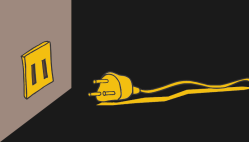
These days it is more common to see type B sockets or what Americans would call a “three prong.” These are used in most of the same countries that use type B and the Japanese plug is slightly different, again. The type B plug has the same two wires as a type A plus a ground lug at the bottom. Because of the orientation, it can only go in one way. In addition, the ground pin is slightly longer, so it will make contact before the other pins and stay in contact longer when removing the plug. It is possible to plug an A plug into a B socket, but there will be no grounding, of course. Also called a NEMA 5-15, this plug is also rated at 15A and like type A, typically carries 110V. The Japanese variant, JIS C 8303 class I carries 100V at 15A.
Type C
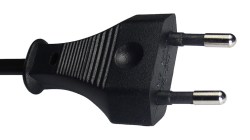
If you’ve been in Europe, you’ve seen type C plugs (CEE 7/16 or CEE 7/17) but the corresponding sockets are not used anymore. Sometimes called a Europlug, they are used in most of Europe with a few notable exceptions (Great Britain, Ireland, Cyprus, and Malta). You can also find them in China and Russia. They are rated to 2.5A (CEE 7/16) or 16A (CEE 7/17) and fit in E, F, J, K, or N sockets. Often, the pins are tapered and flexible to help them fit in various socket configurations. They also fit into some L sockets, but since the high-current L socket has a different spacing, they won’t accept a type C plug. If you had a type C socket, it would fit there, too, but without grounding, these have mostly been replaced. You usually find 250V on these plugs. There are minor variations between countries, and while a British BS 4573 is a type C socket, it won’t accept a Europlug because of different pin sizes. The BS 4573 is an “electric razor” plug meant for plugging into isolation transformers near sinks.
New type H sockets have holes within the slots that allow you to fit a type C plug into the socket. The type O, found in Thailand, can accept a type C, also, but a difference in pin size often causes a loose fit.
Notice that the pins are insulated towards the plug body. This prevents exposed energized conductors while plugging into a compatible socket. The metal parts are only hot when they are covered by the socket. However, the CEE 7/17 plug lacks this insulation and uses fatter pins to increase current for things like hair dryers or vacuum cleaners. Because of the plug body’s shape, these will not fit into a type N socket.
Type D, M
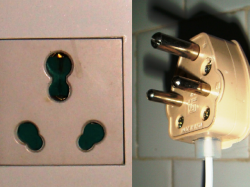
Type E, F, J, K, L, N, O
The type E, F, J, K, L, and N are all similar to a type C, but the socket has some arrangement for ground. This is similar to how the type B socket has a provision for a ground but can still accept a type A plug. A C plug will mostly fit in any of these sockets, although there are some limitations, especially with the type L socket, which is really two incompatible sockets.

The type E has a male pin that serves as a ground installed at the top as opposed to type K, which has the male ground pin on the plug. Type E are common in parts of France, Belgium, Denmark, and Poland, along with a few other countries. The type K outlets are found in Greenland, Denmark, and some other countries.
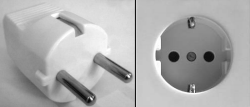
The type F found in countries like Algeria, Bosnia, and Iceland, among others has grounding pins on the side. These are sometimes known by a shortened version of their German name, the Schuko plug.
Type J appears in Switzerland and a few other countries. It is often called a “Swiss 3 pin.” The SEV 1011 is rated for 10A and there is a variant that can handle up to 16A. There is also a two-pin plug that can be made to fit in a type J or type C socket. Most often, you’ll find 220V on these connectors. Type K is found in Denmark alongside C or E sockets.
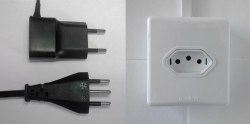
Thailand is the home of type O, a 16A 250V connector with ground. a C , E, or F plug will fit in an O socket loosely.
The type L, used in Italy and North Africa, is the odd connector out of the ones that can take a type C plug. These distinctive plugs have a single row of three pins. The 10A version will accept a C plug. However, the 16A version is spaced wrong because, historically, there was a 127V circuit for lights and a 220V circuit for everything else and they used different plugs. In modern times, the sockets often have a figure 8 pattern on the outer holes so they can accept either version of the plug and these will take a type C plug.
Type G
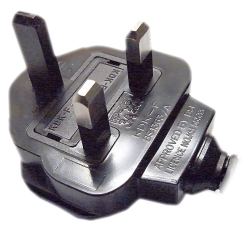
The built-in fuse allows homes to utilize “ring circuits.” That is, instead of a small number of outlets being fed from a branch leaving a central point like a load panel, all outlets can connect to each other in a ring. This means that the central distribution is simplified, but has a much larger circuit protection device than in a radial system. Therefore, each thing that plugs into the ring needs its own, presumably smaller, fuse.
Type H, I, and More
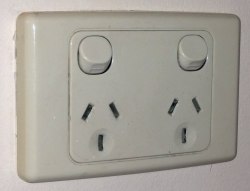
You might think this is everything, but it isn’t. There are also plugs made for electric shavers and endless variations for high-currents or special functions. Then there are connectors for, say, 220V three-phase in the US. Truly a case of the old adage, “The nice thing about standards is that there are so many of them.”
Resources
Many of the plug and socket pairs cover a lot of countries. The handy map below shows what regions use what (although Thailand’s type O seems to be absent; you’ll find A, B, C, F, and O there). Might come in handy if you need to quickly figure out what kind of plug you are dealing with.
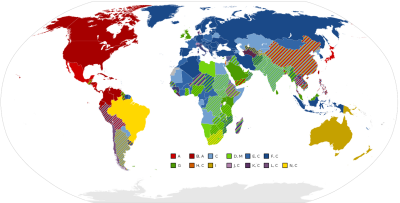
We didn’t use any images from the site, but if you want to see real pictures of pretty much everything, there is the Digital Museum of Plugs and Sockets, proving that you can, indeed, find almost anything on the Internet. For a more technical and interactive experience, there’s always the IEC which helpfully tells you the voltage and frequency to expect, too. How did we arrive at all these plugs? There is some history about that. If you want to get up close and personal with a BS1363 (type G) we can help with that, too.

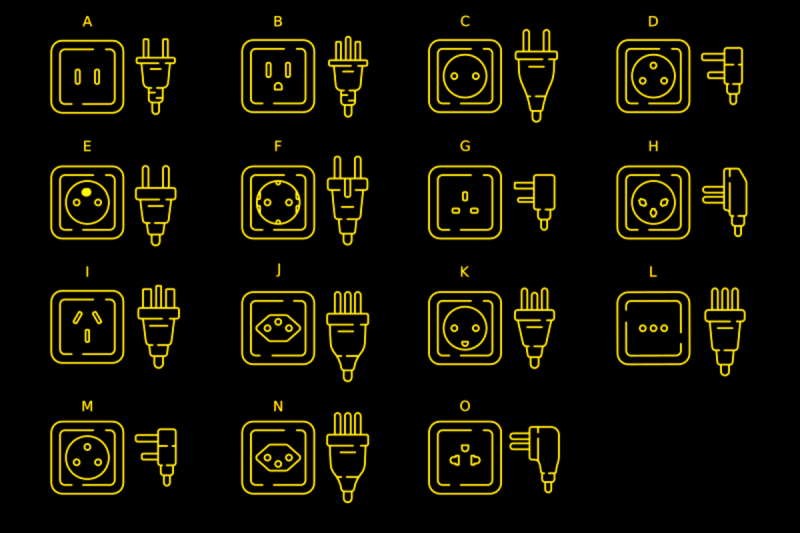














No they haven’t. There are plenty devices that don’t need grounding and high currents (e.g. TV sets) that use these.
You are misreading the sentence: If you had a type C socket, it would fit there, too, but without grounding, these have mostly been replaced.
So… without grounding, [TYPE C sockets] have mostly been replaced. And I still say that is true.
I don’t agree with that statement though, at least in part. While I haven’t seen a Type C *WALL* socket they are definitely common in extension cords. I’d even say they are more often found on extension cords than Type F sockets.
I’m talking about Germany here btw. Don’t know about other countries using those sockets.
I guess if we talk about what is common, we should say where it is common. What is common to me is exotic in asia.
Therefore i guess, there is a good chance that both of you are correct.
That saied, i am from germany, i have never seen a C sockets at all there is only F. But C plugs are common.
Have you ever seen an extension cord with multiple sockets here? They almost always have a mixture of type C and type F sockets.
Type C sockets are still for sale in the Netherlands for new installation. They are still used as most appliances in our homes don’t need grounding. However they are usually not sold as C-type but as ‘socket without grounding’. Even the round type-C plugs are still for sale in hardware stores but those have mostly been replace for the flatshaped ones.
And while it is true that you won’t find round type C sockets, extension cords often have slim sockets that only fit type C plugs to save space.
https://commons.wikimedia.org/wiki/File:Mehrfachsteckdose_(smial).jpg
The grounding pin for type B is supposed to go on the top so that if it’s unplugged slightly and something falls into the gap it will hit the grounding pin first. It’s almost universally installed incorrectly because people like it to look like a face. Hospitals etc have stricter requirements so all of their plugs are correctly “upside down”
This 100%
Except for all the top-heavy wall warts that’ll put a strain on that pin installed that way.
https://www.familyhandyman.com/article/which-is-the-correct-and-incorrect-way-to-install-an-electrical-outlet/
Plugs that are designed to work with the outlet in the wrong orientation are not the fault of the outlet designer. NEC code for residential doesn’t specify orientation, but code for other buildings do specify that ground be up. If you have to install it upside down to account for a plug, the plug was designed wrong. Of course it’s a chicken/egg scenario now because those plugs were designed correctly around outlets that were installed incorrectly.
I live in an old house where they swapped A to B without adding a ground wire. Any outlet that I run a ground to is rotated to ground up to differentiate.
I also live in a n old house and have to second that design flaw: plenty of wall warts I’ve used fall out of that incorrect “face” orientation too.
You can install a GFCI in place without adding a grounding conductor, *IF* you install it correctly and label the GFCI and any downstream sockets with the included stickers “NO EQUIPMENT GROUND” to indicate it as such.
Never understood how US prongs could be safe : you can touch the live half plugged connector.
On the other side, the EU connectors (10 and 16A) cannot expose live pins.
They are only 110v and you only do it once before you are more careful. I did it at 7 years old standing on the bathroom vanity plugging into the light fixture and it knocked me off onto my head after it shook me for a while. Have not made the same mistake again.
Quite the social-Darwinistic approach. 120V dead is the same as 240V dead.
Need to protect people from stoves as well.
Dead is dead, but 120V is _much_ less likely to kill you.
> but 120V is _much_ less likely to kill you.
120 Volts is plenty enough to cause ventricular fibrillation if you get zapped across the chest. 240 Volts causes twice the current of course, but already at 120 Volts you can get 30 mA through your sweaty fingers and touching 240 Volts would simply make you double dead… You’re unlikely to find yourself in a situation where you’d be just conductive enough that 240 Volts would kill you and 120 V would not.
“A sustained electric shock from AC at 120 V, 60 Hz is an especially dangerous source of ventricular fibrillation because it usually exceeds the let-go threshold, while not delivering enough initial energy to propel the person away from the source.”
Having survived both at various times (I was fortunate enough to have too much electrical resistance to be harmed or to be unable to simply move away), I believe the marginal situations where 120 wouldn’t be able to pass enough current are still important. One of the only times I was shocked by something wired for 240, it passed through the ground to electrify a metal object which I inadvertently brushed against.
Of course, in the USA with split phase our 240 is only truly 240 when you are unlucky enough to be between both phases; it’s 120 between each one and ground. (Speaking of RMS in all cases ofc).
However, we also have very similar outlets which carry 240, and they are often still mounted with the ground plug on the bottom, so the above is a bit less relevant.
Really the best thing is a fault circuit interrupt – gfci, afci, whatever sort – to stop these sorts of problems, instead of turning the outlet upside down.
Given that the fix is a tiny bit more plastic forming sleeves on the blades, if still feels like a very unnecessary risk. Particularly since US outlets don’t all have ground fault protection (for comparison, Australian Type I plugs have sleeves on live and neutral, and Australian homes also having mandatory whole residence ground fault protection). I get that 120V is less likely to cause issues but it’s still pretty dangerous to have almost no safety features at all.
360 million resident in USA, estimated 140 million houses, estimated 120 million buildings (some with thousands outlets), and nearly 100 years old plug standard, I doubt anyone is willing to invest a major overhaul in outlet and plug design. Companies won’t design their devices with new plug unless plenty of houses and building has new outlet, builders aren’t likely to use new outlet since people would complain their $10 toaster and $50 bargain bin TV doesn’t fit.
A possible solution is to mandate new style plug design in all future building and all major remodeling, and offer adapter with old style female to new style male plug for users with older devices. The rest of existing building will be encouraged to replace the current type A and B outlet with new style over time as more of their devices with obsolete type A male plug gets broken down and replaced.
PS and require all extension with new style plug to have built in fuse!!! Cheap no name extension cord are often rated low like 10A, too often people don’t pay attention and connect cheap extensions to a 15A space heater, causing house fire. Christmas light are much safer as extension cord due to built in fuse FFS…
This is, unfortunately, not codified. Ground pin up, or to the left when facing a sideways mounted outlet (so the grounded/neutral current carrying stab is on top, hot on the bottom), is preferred when you want to minimize risk from things falling onto an incompletely inserted plug. Ground up also is less likely to fall out, reputedly, due to the ground stab being larger and longer.
Unfortunately, most devices and end-caps that have a designed orientation are designed for ground-stab down. The most common NEMA 14-30 and 14-50 used on electric clothes dryers, stoves, and, recently, high capacity home car charging stations get ti right, though. Unless, of course, you live in an old house that has been retrofit one two many times and the outlet is plastered in the wrong way up, like I do. One day, I will break open the wall and fix it, but will likely need to run new wire, which is one reason I haven’t.
Interestingly theres even debate among German electricians (esp. in forums, go figure!) if neutral of the Schuko standard outlet is left or right.
You can plug in everything as you like, but sometimes the argument is, that most grounded plugs are put in with the cord facing the floor and that then the switched wire inside grounded appliances with only a single pole switch would always be the live wire…
“Hospitals etc have stricter requirements so all of their plugs are correctly “upside down””
Not so in any of the US hospitals I’ve ever worked in. And that’s a lot.
They do have green dot “hospital approved” outlets (I believe this indicates ungrounded state like in the ORs, for that there is a line isolation monitor) and there are red outlets for critical equipment that are on the generator in case our outages so people don’t, like, immediately die.
Also, risk of some conductive object falling on a partially unplugged outlet is way less than dumping some conductive liquid (IV bag) onto an outlet. I’ve seen and done that plenty, nothing happens.
I usually see them correctly installed in hospitals and some commercial area that are open to public. But many home sometimes have “upside down” outlet usually done by DIY-er replacing the obsolete non-grounded outlet (and sometimes without ground connection!!)
Or anywhere the fire marshal feels like being a jerk. One of my former employers was forced to flip all the outlets in their building to ground side up to avoid fines being levied by the fire marshal, but that same idiot also insisted we had to put “child safety plugs” in all the receptacles despite them being tamper-resistant shuttered outlets which require a ground pin to unlock the live conductor shutters. They also took issue with temporary installed equipment with see-through covers over the terminals, despite the fact the equipment was installed above ladder height on a backstage walkway and did in fact have covers over the live terminals.
The “ground on top” thing is relatively new. Our work building doesn’t have it (Boston, renovated in 2016). It seems to be a local option kind of thing, since as someone posted below, NEC is silent on orientation.
I think it looks wrong, and I haven’t seen any data to indicate that ground-on-bottom is in any way hazardous. If that were the case, NEC would have mandated ground-on-top.
[citation needed]
The UK plugs are great for electrical safety, but don’t tread on one in bare feet, and don’t trip over a chord while plugged in (with the chord exiting the plug at the bottom, instead of the plug pulling out, the wall socket often cracks).
What kind of shonky wall sockets are you buying? I’ve never seen a cracked socket and I might be the clumsiest person in all of human history.
That’s funny, I never see you at the meetings ;)
Here’s an anecdote from .au. Every single light switch in our 1989 townhouse developed cracks in the plastic escutcheon around the switch lever. No idea why. Bad batch of plastic at the factory? They were not exposed to sunlight or harsh cleaning chemicals, or physical load on the switches. In 2020 I replaced *every single switch* in the house. I guess i’ll find out if the new ones are better after a few more decades…
I’ve never cracked one or seen a wall socket cracked and I’ve been around more than enough workshops and other environments where almost anything would get damaged eventually.
Only time I’ve seen a failure was screwing super-cheap B&Q Value switches or outlets onto a back box and the plastic around the screw cracked, but that’s their uber-crappy plastic.
My office has plastic trunking round the wall which holds power and networking. The way the power sockets are attached is not very strong, and it only takes one person tripping over a power cable to permanently wreck them.
I’ve also seen some wall sockets where the plastic has started to chip away around the pins. I assume that’s because they’re decades old and the plastic has gone brittle.
Sounds like you’re trading electrical safety for a chance of killing yourself falling or being poor from all the plugs you have to buy :P
I think the best type of plug would be a Type G with the hot and neutral plugs rotated like on the Type I, but then again do we need another standard?
When I used to work on telephony equipment in the labs there was a type G with the line and neutral prongs rotated by 90 degrees. This supplied 50VDC which was/is standard for a lot of telephony stuff.
Oh, and there are never enough standards:)
Oblig: https://xkcd.com/927/
No need to rotate them – because the earth pin MUST be present in a UK plug, it is physically impossible to insert it the wrong way. There are also shutters over the live and neutral pin sockets on the wall that are only opened by the (slightly longer) earth pin on the plug being inserted.
I grew up with Type I plugs in Australia, now live in the UK and admire the Type G plugs immensely.
The chinese “type I” differs from AU/NZ by being inverted and having slimmer pins (that may be loose in a AU/NZ socket)
For the past 20 years, AU&NZ have required part-insulated pins similar to the ‘type C’ shown above.
The standard ‘type I’ is rated 10A, but where higher current is required, variants exist:
– 15A active and neutral pins are unchanged, but the earth pin is wider
– 20A all three pins are ‘wide’ like the 15A earth
(above that, they start getting weird)
I’ve never been a fan of the Australian I socket.
The plug has the disadvantage of the physical bulk of the British plug, but without the benefit of the solid socket retention from those big British conductor posts.
The change to having the two AC contacts flattened and angled inwards, at least in my experience, seemed to make for a plug that always wanted to fall out of the wall.
If you’ve lived in North America or Japan and have used type A you’ll realize that the tiny change of rotating the pins is simple but brilliant, impossible to plug in backwards.
Contemporary (like in the last 25 years or so) type B sockets (NEMA 15-5) in North America now have different sized blades. The hot side is the same width as the old plug, the neutral side is about 30% wider.
An old, ungrounded type A plug will go in either way, as will a plug for a device that doesn’t care, like a 2-blade wall wart that has blades of equal size. But a modern plug for a device that does care about which side is hot will only go in one way
Disagree on all your points.
The AU/NZ plug is much small then the UK plug. It is about the same size as the US 3-pin plug
Angled contacts actually make them more stable.
Chunky wallwarts with undersized (chinese) pins are often loose – true, but they are non-complient, so hardly the fault of the design.
Only the schoko recessed socket provides non-pin support.
The polarised design also means it is always the active that gets switched.
All things considered, it’s one of the least-worst designs.
The US plug used to be the AU/NZ one, dunno why they changed.
As to size, the pins are spaced exactly the same, so if one wanted to one could take a pair of pliers and twist the pins on a US plug and it will fit perfectly into an AU socket. Not that I would ever do something like that.
Type I is actually a fair bit smaller than type G, it’s only a bit larger than the equivalent US designs (particularly since earthless plugs exist here), and it still includes pretty much all of the most important safety features of the type G (Australian houses have radial circuits so don’t benefit from the fuse, and while outlets aren’t typically shuttered here they’re also smaller holes so it’s not as important).
Just an interesting and maybe helful tidbit on China pretty much the ‘standard’ plug has two different sockets top and bottom. One “universal” two-prong that can take A or C on the top, and one grounded I on the bottom. I saw this in office buildings, banks, airports, hotels, and medical facilities new and old both. I found this oddly hard to find online before going.
So if you are American or from mainland Europe and just need to plug in a phone charger or two-prong laptop you are pretty much set (assuming it cake take 230V, as most things can now). If you have things that are three prong you’ll need a type I connector.
My hotel did have one of the “everything” universal connectors as well, but I always find them to be flaky and more then a bit unsafe.
“ many things expected either 125V or 250V and didn’t work with the opposite voltage.”
Well sometimes the not working was also accompanied by lots of smoke, a very loud 50Hz hum, and then sparks, quickly followed by odd looks from your co-workers and sad face;( speaking from experience after a colleague set the voltage selector to 110V on a very expensive Philips signal generator in the uk.
That’s annoying… I always put some tape over the voltage selector on equipment (if the equipment has one, most of the modern stuff uses “universal” switch mode PSU anyway).
Used to be the most fun with old electric shavers set to the wrong voltage.
Watch your face.
Europe’s (And UK’s) mains voltage is 230V, not 250V. Although 250V is within the +-10% bounds.
Still hurts though.
https://www.twothirtyvolts.org.uk/pdfs/site-info/Explanation_230Volts.pdf
Perhaps it’s changed again, but it was at least orignally just an epic EU fudge if not technically a lie.
UK is 240 but anything between 216-253 is permissable
Wall sockets for type C plugs only may still be found but they have an internal separation transformer and are used only inside the bathroom for small power appliances (I have one at home).
A nice, quick follow up might be a short discussion of the other end: IEC60320?
Type I (AU/NZ/+) has multiple variants for different currents from 10A to 32A. What is cool, is that a lower current plug can always go into a higher current socket.
https://en.wikipedia.org/wiki/File:Australian_mains_socket_styles_for_different_current_ratings.jpg
Same for the Swiss standard where round 10A pins fit into rectangular 16A holes. They also designed their 3 phase sockets to accept a single phase plug. Most sockets are 10A single phase, though, with 16A and 3 phase sockets limited to rooms where you would operate beefier devices like washing machines.
I have seen some type A and B in USA homes and small business with one sideway T that is rated for 20A instead of usual 15A for that rare appliance that uses 110v 16A to 20A. The plug usually had one vertical and one horizontal blade to fit the 20A outlet but I have yet to find any device with that kind of plug.
And in my old house (built around 1930s), there were type A outlets with 2 sideway T’s, supposedly for 25A according to a very old electricity guide book. This is obsolete and should be replaced with standard type B, 15A or 20A. If something is going to need a lot of power, it’s usually more efficient to use 220v instead, and some USA houses did have 220v for appliances like electric stoves, electric water heater, etc.
Never heard of 127V in Italy:
the only difference, if any, is for 10-16 A circuit and breakers.
The UK’s type G plug did not replace type K, it replaced type D, as stated in the type D paragraph.
And type M. For many years after the switch, type D was still used on railway carriages, and for table lights in hotel rooms (primarily to stop guests “borrowing” power for their own appliances.
You can still buy type D and it’s still used for lighting and other circutirs which you dont want people plugging anything in.
There are various variations on the BS1363 too which typically have oddly shaped earth pins. T, round, etc.
It would be nice to get a BS1363 plug on which the cable exited through the top, similar to what our european and US based cousins enjoy. But they are either hard to find or expensive.
And you get the as many letters as you can stick in one socket adapters and sometimes extension leads which bless the Chinese manufacturers save them lots of money whilst compromising safety.
“Fall out of the wall”? Really? I’ve never, ever seen that happen. And I’ve kicked a few laptop power bricks in my time. Never seen a plug completely let go.
Retention is a matter of build quality – never encountered a “loose” wall socket, but sometimes I find a power board that’s a bit easy to connect/disconnect.
One advantage of the “I” design is that it’s impossible to mis-connect.
Not impossible to mis-wire, but that’s not a fault of the design.
“Japanese type A plugs have two blades of equal size. […] The two pins, of course, are the AC hot and neutral wires.”
Not true in Japan. They have 100V with center neutral, so both pins are phase (hot), but only 50V with respect to ground. This is similar to the center-ground 110V (via isolation transformer) widely used on building sites in the UK, with IEC 60309 connectors.
Israel at 50V? I do not seem to remember it like that. Also 50V is really (, REALLY) at the low end of efficient electrical power transport for normal household power usage numbers.
Yes its completely untrue. Israel is 220-240 volt with 2 prongs that fit most of europe plugs or 3 prongs that is more unique.
In the Netherlands the Type-C is still rather ubiquitous.
I mean sure they aren’t being used in new constructions anymore, but the Netherlands is filled with houses (incl mine) that are at least a couple decades old and those lack grounding running through the entire house. Instead only having grounding for the select few points it is mandatory: mostly Kitchen, Heating, Ventilation and bathroom. So type-C sockets are still visible all over the place and still being sold by hardware stores.
I was overjoyed when i was building my lab-space to spot that signature yellow-green striped cable in the back of the divider box, apparently the room is where the main ground wire to the attic passes through. So i was able to easily make the most important room grounded.
Both types D & M can still be found in the UK.
If you’re in a hotel, check out the outlets for the table/standard lamps, which can sometimes be a type D. Occasionally found in the public areas, and more often behind the side tables in the rooms. They’re usually on a low current lighting circuit, so having a non standard outlet stops guests and cleaners blowing the breakers with kettles, hoovers, etc.
Type M is still commonly used in theatre lighting environments, but their use has been slowly declining for many years.
Side note: despite the common form factor shared by types M and G, the older M types (these days usually manufactured by Duraplug), require the outer cover to be slid onto the cable before termination. Therefore, any plug/socket termination, regardless of size or type, which is followed by ‘oh fuck I forgot to put that bit on first’, is, for me, called ‘Doing a Duraplug’ – something I happily adopted from a very good crew boss and friend in the lighting industry.
We’ve all been there in sime way shape or form – I just like that it has a name now.